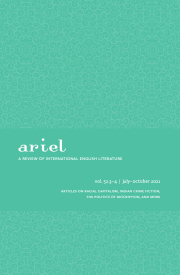Stung by a Charso-Bee: Daljit Nagra’s Macaronic <i>Ramayana</i>
Keywords:
Daljit Nagra, Ramayana, adaptation, code-switching, macaronicAbstract
This essay argues that Daljit Nagra’s idiosyncratic adaptation of the Ramayana, in which the poet combines multiple versions of the ancient epic (from different parts of the Indian Subcontinent and Southeast Asia) is more than just a comic version of the Sanskrit classic but represents a serious attempt to ensure an old text’s relevance for a new readership. One way that Nagra manages to reach a highly diverse and widely dispersed audience is through the extensive use of interlingual wordplay, a technique that stylistically echoes the earlier diasporic writer Salman Rushdie. Reading this transnational version of the Ramayana through the lens of Jahan Ramazani’s concept of a macaronic poetics, the essay analyzes the lexicological, phonological, and typographic effects of Nagra’s poem, which combine to produce a faithful retelling of the ancient Hindu epic in a language and style that is thoroughly of the 21st century and that uses translingual puns to connect the Ramayana to a western audience as well as the Indian diaspora.


